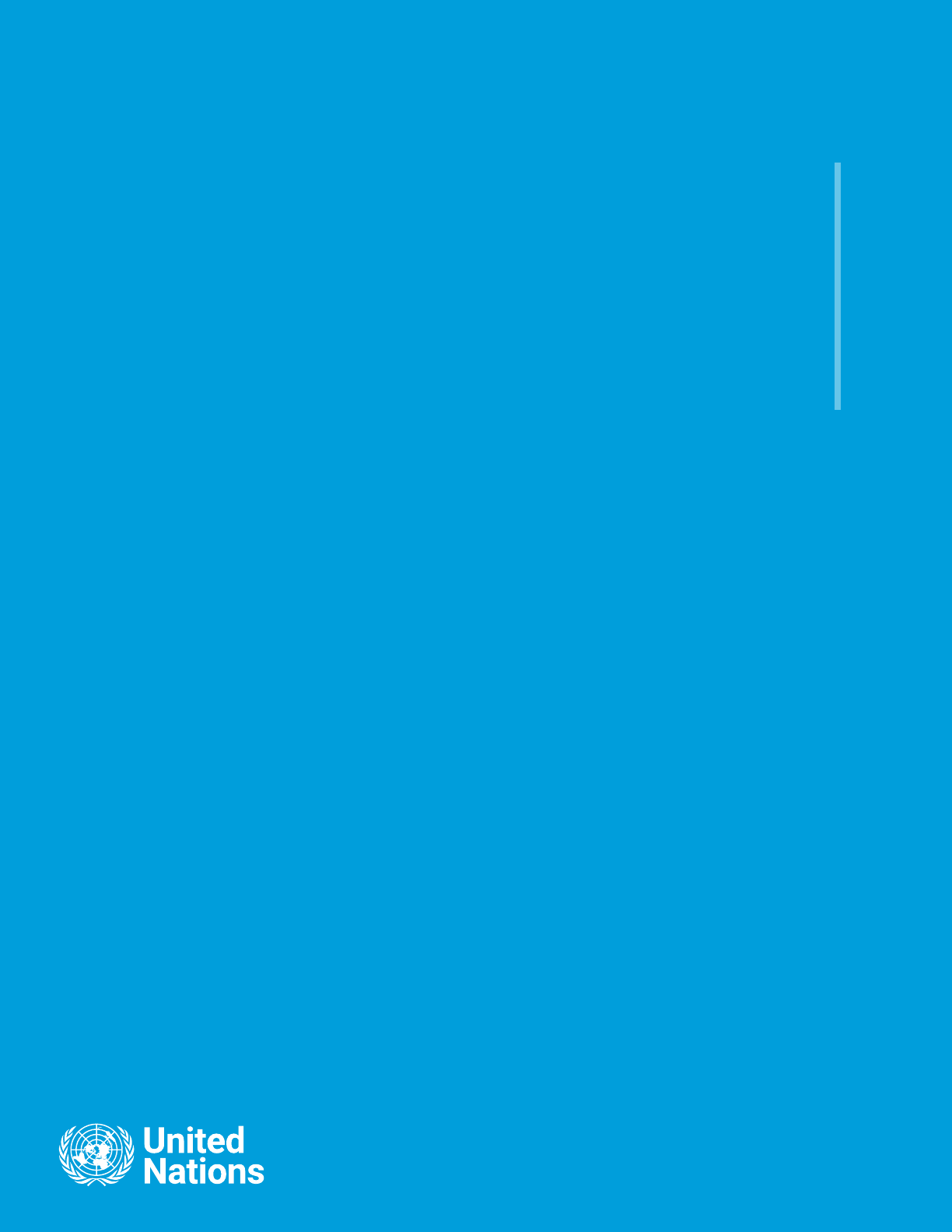
Policy Brief:
COVID-19 and
People on the Move
JUNE 2020

Executive Summary
COVID-19 leaves few lives and places
untouched. But its impact is harshest for
those groups who were already in vulnerable
situations before the crisis. This is
particularly true for many people on the
move, such as migrants in irregular
situations, migrant workers with precarious
livelihoods, or working in the informal
economy, victims of tracking in persons as
well as people eeing their homes because
of persecution, war, violence, human rights
violations or disaster, whether within their
own countries — internally displaced persons
(IDPs) — or across international borders —
refugees and asylum-seekers.
The disproportionate impact of the COVID-
19 pandemic on people on the move
presents itself as three interlocking crises,
exacerbating existing vulnerabilities.
1
•
First, a health crisis as people on the move
nd themselves exposed to the virus with
limited tools to protect themselves. In addi-
tion to their often poor or crowded living
or working conditions, many people on the
move have compromised access to health
services due to legal, language, cultural
or other barriers. Particularly impacted
are those migrants and refugees who are
undocumented and who may face detention
and deportation if reported to immigration
authorities. Many people on the move also
lack access to other basic services – such as
water and sanitation or nutrition – and those
in fragile, disaster-prone and conict-affected
countries are facing higher risks owing to
weak health systems, which is compounded
by travel restrictions constraining delivery
of lifesaving humanitarian assistance.
•
Second, a socio-economic crisis impacting
people on the move with precarious live-
lihoods, particularly those working in the
informal economy with no or limited access
to social protection measures. The crisis
has also exacerbated the already fragile
situation of women and girls on the move,
who face higher risks of exposure to gen-
der-based violence, abuse and exploitation,
and have diculty accessing protection
and response services. Meanwhile, loss
of employment and wages as a result of
COVID-19 is leading to a decline in migrant
remittances, with devastating effects for
the 800 million people relying on them.
•
Third, a protection crisis as border closures
and other movement restrictions to curb the
spread of COVID-19 have a severe impact
on the rights of many people on the move
2 POLICY BRIEF: COVID-19 AND PEOPLE ON THE MOVE
1 While all people on the move are equally entitled to the same universal human rights, the impact of these three inter-locking crises is not
uniform across the wide span of people on the move covered in this policy brief as it depends on the context, their socioeconomic situ-
ation and legal status under national and international law, as well as intersecting factors like age, gender and disability. While IDPs are
mostly citizens or habitual residents of their own countries and should have access to equal rights as their fellow nationals, international
migrants and refugees are distinct groups governed by different legal frameworks, with refugees entitled to the specic international
protection dened by international refugee law. Victims of tracking in persons are afforded specic protections as outlined in various
United Nations Conventions and Instruments.

who may nd themselves trapped in deeply
dangerous situations. Asylum-seekers may
nd themselves unable to cross interna-
tional borders to seek protection and some
refugees may be sent back to danger and
persecution in their country of origin. In
other instances, migrants may be forcibly
returned to their home countries with frag-
ile health systems, which are ill-prepared
to receive them safely, while returning IDPs
may face a similar predicament in their
home localities. Aditionally fear of COVID-19
is exacerbating already high levels of xeno-
phobia, racism and stigmatization and has
even given rise to attacks against refugees
and migrants. In the long-run there is a risk
that COVID-19 may entrench restrictions
on international movement and the cur-
tailment of rights of people on the move.
COVID-19’s disproportionate impact on
people on the move contrasts with their
outsized role on the frontlines of responding
to the crisis - highlighting their broader
contributions to societies around the world
- while caring for the sick and elderly or
keeping up food supplies during lockdowns.
Against this background, the COVID-19 crisis
presents us with an opportunity to reimagine
human mobility for the benet of all while
advancing our central commitment of the 2030
Agenda to leave no one behind. In the pursuit
of this objective, this Policy Brief offers four
basic tenets to guide our collective response:
1. Exclusion is costly in the long-run whereas
inclusion pays off for everyone: Exclusion
of people on the move is the very same
reason they are among the most vulnerable
to this pandemic today. Only an inclusive
public health and socio-economic response
will help us suppress the virus, restart
our economies and stay on track to reach
the Sustainable Development Goals.
2. The response to COVID-19 and protecting
the human rights of people on the move
are not mutually exclusive: COVID-19
has not stopped people from eeing
violence or persecution. Many countries
have shown that travel restrictions and
border control measures can and should
be safely implemented in full respect
of the rights of people on the move.
3. No-one is safe until everyone is safe: We
cannot afford to leave anyone behind in our
response and recovery efforts, especially
those people on the move who were already
most vulnerable before the crisis. Lifesaving
humanitarian assistance, social services and
learning solutions must remain accessible
to people on the move. For all of us to be
safe, diagnostics, treatment and vaccines
must be universally accessible, without
discrimination based on migration status.
4. People on the move are part of the solution:
The best way to recognize the important
contribution made by people on the
move to our societies during this crisis
is to remove barriers that inhibit their
full potential. This means facilitating the
recognition and accreditation of their
qualications, exploring various models
of regularisation pathways for migrants
in irregular situations and reducing
transaction costs for remittances.
There are encouraging steps already taken by
many governments in this direction, some of
which are highlighted in this Brief. The four basic
tenets offered by this Brief are underpinned
by our collective commitment to ensure that
the responsibility for protecting the world’s
refugees is equitably shared and that human
mobility remains safe, inclusive, and respects
international human rights and refugee law, as
envisaged not least by the Global Compacts
on Refugees and for Safe, Regular and Orderly
POLICY BRIEF: COVID-19 AND PEOPLE ON THE MOVE 3
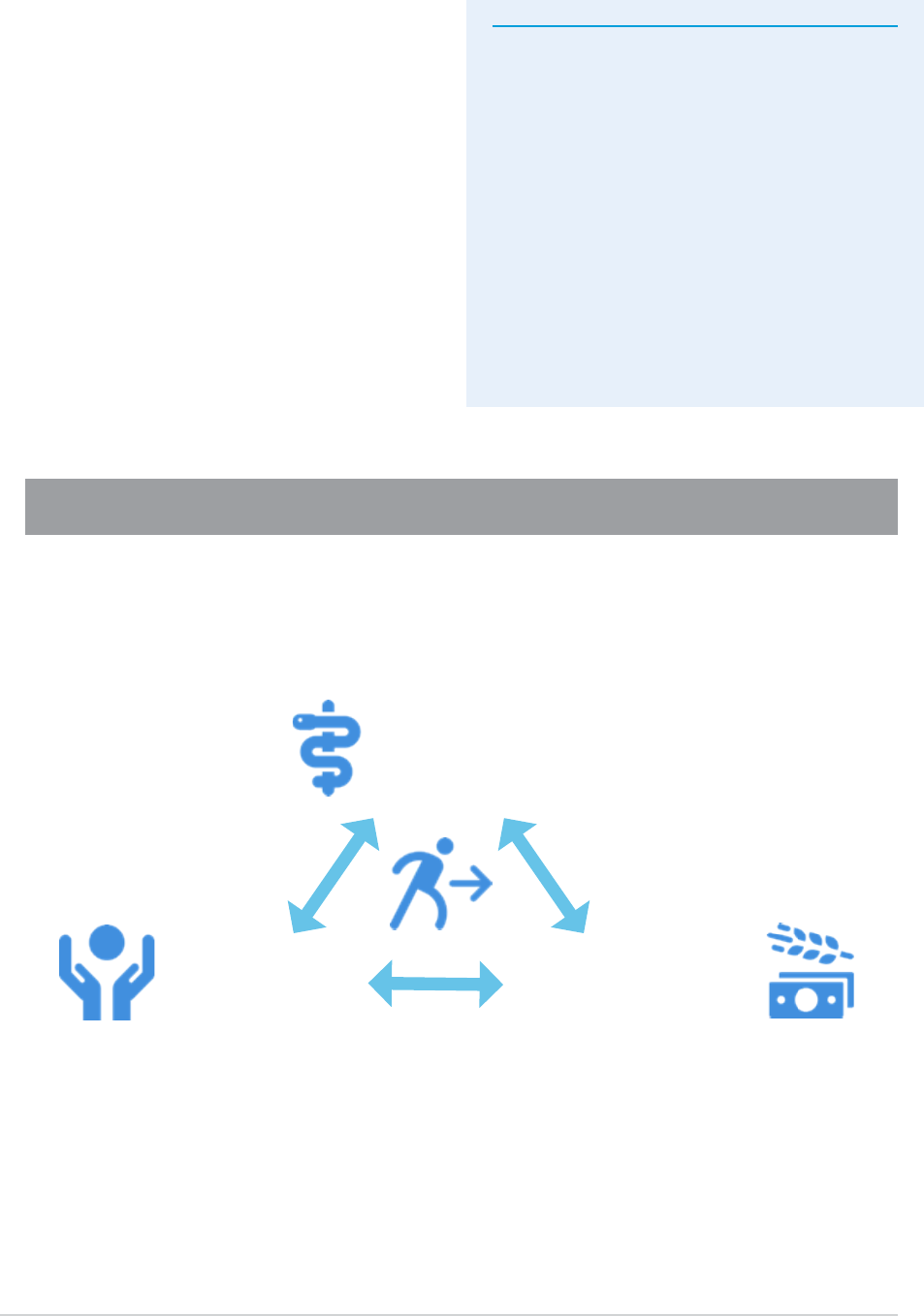
Migration. They also reinforce the notion that
no one country can ght the virus alone and
no one country can manage migration alone.
But together, we can do both: contain the
virus’s spread, buffer its impact on livelihoods
and communities and recover better.
FOUR BASIC TENETS TO ADVANCING SAFE
AND INCLUSIVE HUMAN MOBILITY DURING
AND IN THE AFTERMATH OF COVID-19:
1. Exclusion is costly in the long-run whereas
inclusion pays off for everyone.
2. The response to COVID-19 and protecting the
human rights of people on the move are not
mutually exclusive.
3. No-one is safe until everyone is safe.
4. People on the move are part of the solution.
4 POLICY BRIEF: COVID-19 AND PEOPLE ON THE MOVE
THREE CRISES IMPACTING PEOPLE ON THE MOVE
Protection crisis Socio-economic crisis
Health crisis
•
Unsanitary and crowded living conditions (e.g. some
refugee camps have a population density that is 1,000
times that of surrounding host communities.)
•
Compromised access to health services
•
Food insecurity (e.g. more than half of the world’s
refugees and IDPs live in countries and communities
that feature high levels of food-insecurity.)
•
Curtailed access to asylum an (e.g. 99 countries
are making no exceptions for admission of asylum
seekers at closed borders)
•
Detention, forced returns and deportations
•
Stranded migrants, family separation and human
smuggling
•
Rising unemployment and loss of livelihoods
(e.g. over half of the refugees surveyed by UNHCR in
Lebanon reported having lost their already meagre
livelihoods)
•
Decline in remittances (e.g. remittances will drop by a
total of USD$109 Billion in 2020 due to COVID-19)
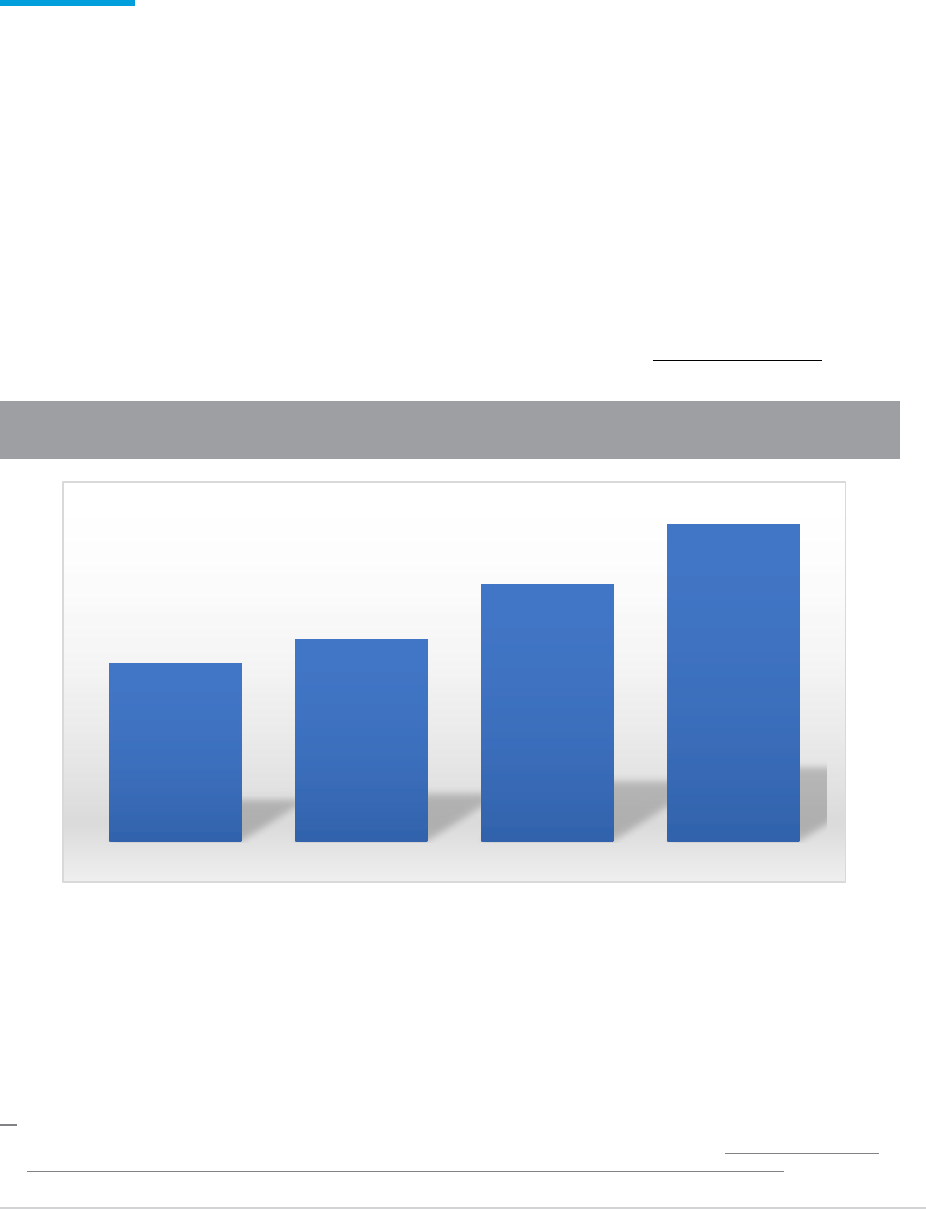
Migrants, Refugees and Internally Displaced
Persons in Numbers
POLICY BRIEF: COVID-19 AND PEOPLE ON THE MOVE 5
2 United Nations, Department of Social and Economic Affairs (2019), International Migration 2019, available at: https://www.un.org/en/
development/desa/population/migration/publications/migrationreport/docs/InternationalMigration2019_Report.pdf
UNDESA
2
TOTAL NUMBER OF INTERNATIONAL MIGRANTS, 1990–2019 (MILLIONS)
1990 2000 2010 2019
153
173.6
220.8
271.6
International Migrants
Based on ocial government data, the number of international migrants at mid-2019 is estimated to be around
272 million persons, dened for statistical purposes as persons who changed their country of residence,
including refugees and asylum-seekers. Since 1990, the global number of international migrants has
increased signicantly faster (78 per cent) than the global population (45 per cent). The share of international
migrants in the total population increased by more than six percentage points in Northern America, by
around four percentage points in Europe and Oceania, and by more than three percentage points in Northern
Africa and Western Asia. In other regions it remained stable or declined slightly (United Nations, 2019).
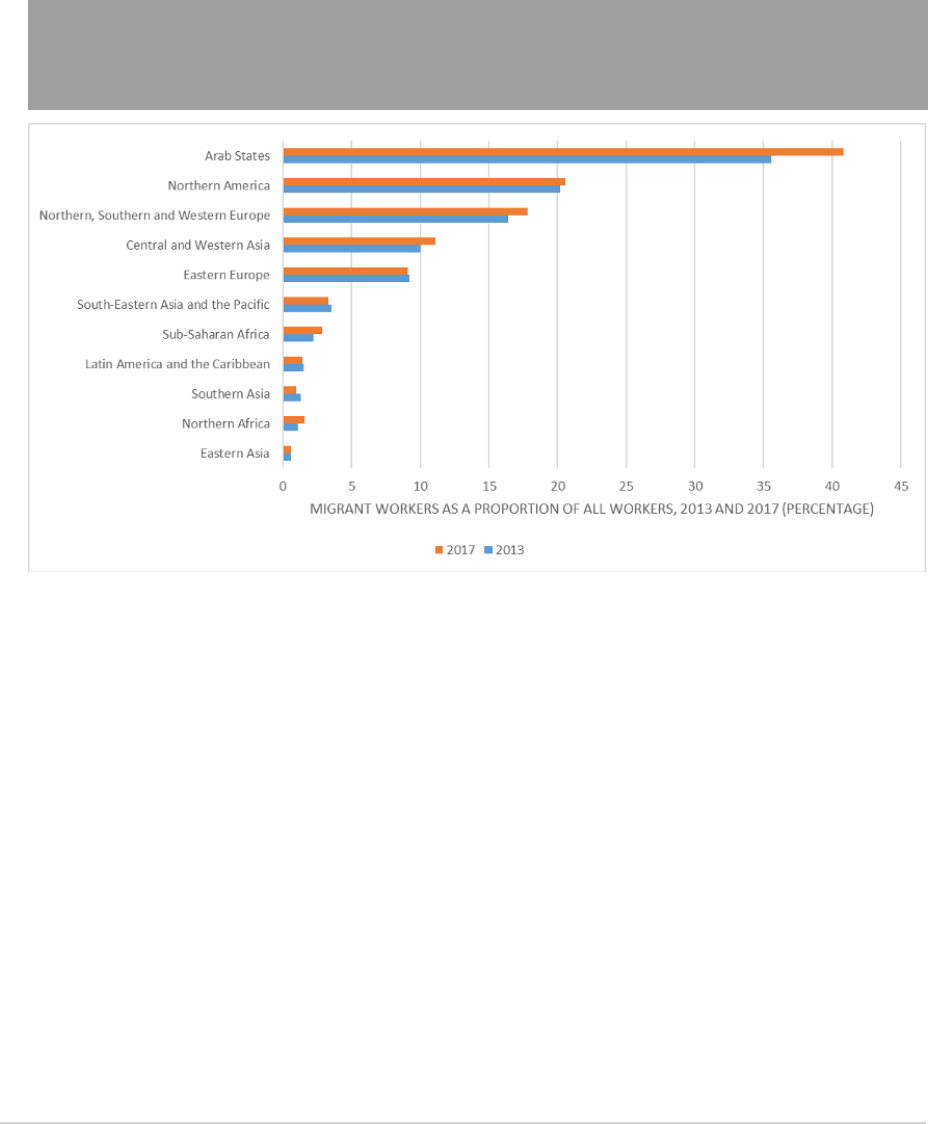
International Migrant Workers
According to the International Labour Organisation, globally there are 164 million international migrant workers
around the world. In terms of the share of migrant workers in all workers, gures are highest – and have been
increasing in recent years - in Arab States, Northern America, Western Europe, and Central and Western Asia.
6 POLICY BRIEF: COVID-19 AND PEOPLE ON THE MOVE
Source: ILO
MIGRANT WORKERS AS PROPORTION OF ALL WORKERS,
2013 & 2017 (PERCENTAGE)
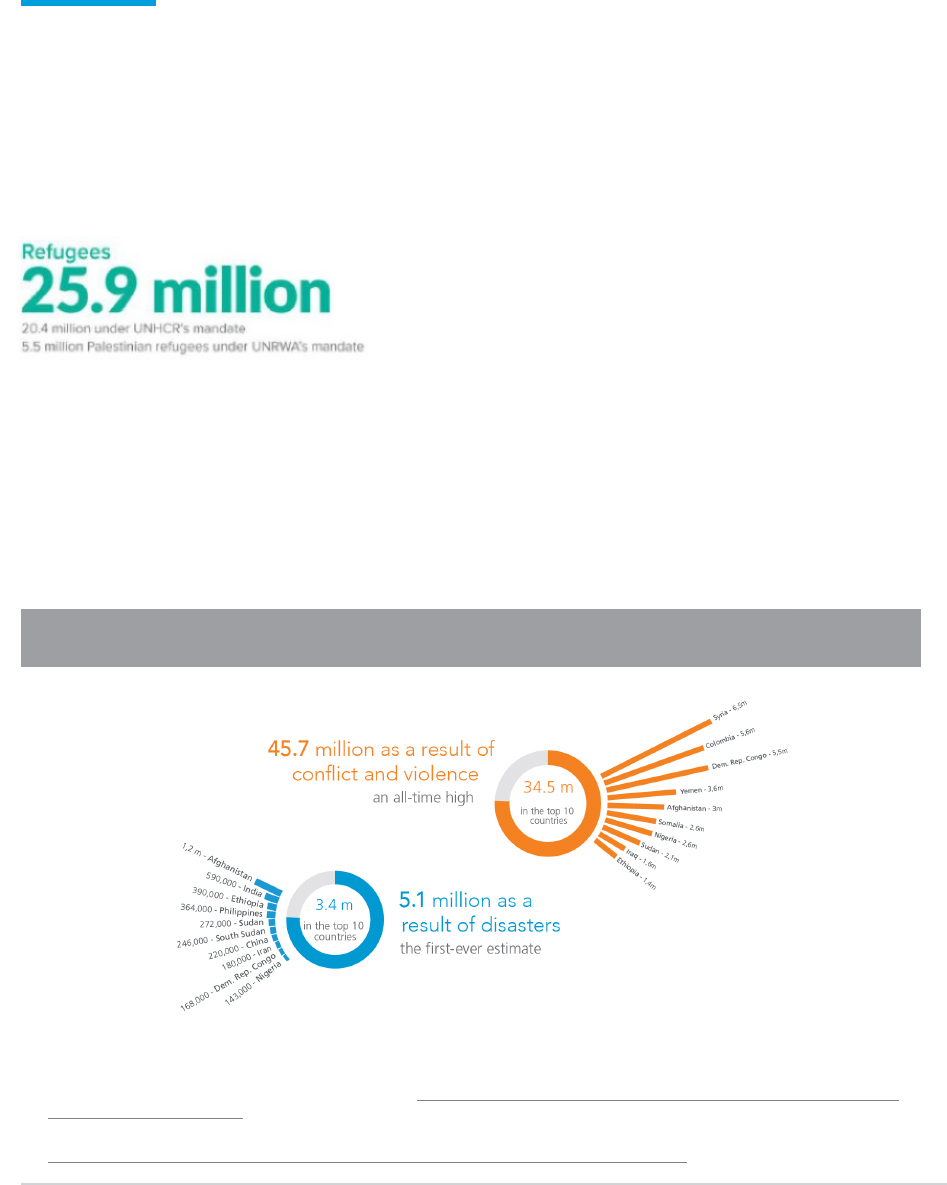
Refugees
The global refugee population stood at 25.9 million at the end of 2018 and is now at the highest level ever
recorded. Eighty-four percent of the world’s refugees are in countries in regions surrounding their countries
of origin, while one third (6.7 million) are in Least Developed Countries. Altogether, nine of the top ten
refugee-hosting countries were in developing regions and 84 per cent of refugees lived in these countries.
Internally Displaced Persons
The global number of Internally Displaced Persons is estimated at 50.8 million persons as of the end of
2019. 45.7 million are displaced as a result of conict, 5.1 million as a result of disasters. This number
has never been higher.
POLICY BRIEF: COVID-19 AND PEOPLE ON THE MOVE 7
Source: Internal Displacement Monitoring Centre
4
TOTAL NUMBER OF INTERNALLY DISPLACED PERSONS
3 UNHCR (2019), UNHCR Global Trends Report, available at: https://www.unhcr.org/dach/wp-content/uploads/sites/27/2019/06/2019-
06-07-Global-Trends-2018.pdf
4 Internal Displacement Monitoring Centre (IDMC) (2020), Global Report on Internal Displacement (2020), available at:
https://www.internal-displacement.org/publications/2020-global-report-on-internal-displacement
Source: UNHCR
3
Migrants, Refugees and Internally Displaced
Persons in Numbers

8 POLICY BRIEF: COVID-19 AND PEOPLE ON THE MOVE
1. The health and
humanitarian impact
People on the move in vulnerable situations
are particularly exposed to the health impact
of COVID-19. Many live or work in crowded or
unsanitary conditions where COVID-19 can
easily spread. Their access to health may be
compromised, particularly when they are
undocumented or excluded. They also often
lack access to other basic services – from
housing to water and sanitation, from food to
social services and from education to social
protection.
5
The health risks are compounded in fragile,
conict-affected and humanitarian settings,
in which large numbers of refugees and IDPs
live and where health systems are weak. While
recent reports of cases in crowded refugee and
IDP camps and settlements, such as those in
South Sudan, Bangladesh and Kenya, remain
comparatively low, there are fears that it will rise
in weeks and months to come, as capacities
to contain the virus and deal with its impact
are limited. For example, according to the
UN-OCHA COVID-19 risk index, which reects
both vulnerability and response capacity,
6
the
10 countries most at risk of COVID-19 host a
combined 17.3 million IDPs.
7
These risks are
compounded by weak health systems and
travel restrictions, which are severely impeding
access to lifesaving humanitarian assistance.
Urgent action to include people on the move and
their host communities in COVID-19 responses
and protect them from the pandemic’s worst
impact is in everyone’s best interest.
UNSANITARY AND CROWDED
LIVING CONDITIONS
AND LIMITED ACCESS
TO BASIC SERVICES
Many people on the move lack an adequate
standard of living which makes them extremely
vulnerable to the pandemic. IDPs, refugees and
many migrants – especially those in irregular
situations — live in crowded conditions — in
camps or informal settlements, in slums,
collective shelters, dormitories, immigration
detention centres, or situations of homelessness
- where washrooms, cooking and dining
facilities are shared, conditions are unsanitary
and physical distancing and stay-at-home
measures virtually impossible to implement.
For instance, Kakuma refugee camp in Kenya
has a population density about 1,000 times that
of the host Turkana community.
8
In Somalia,
there are around half a million IDPs who ed a
combination of conict and climate factors living
in crowded settlements throughout Mogadishu,
one of the fastest growing cities in the world.
5 OHCHR (2014), The Economic, Social and Cultural Rights of Migrants in an Irregular Situation, available at: https://www.ohchr.org/
Documents/Publications/HR-PUB-14-1_en.pdf
6 OCHA (2020), Global Humanitarian Response Plan Covid-19, available at: https://www.unocha.org/sites/unocha/les/GHRP-COVID19_
May_Update.pdf
7 Internal Displacement Monitoring Centre (IDMC) (2020), Global Report on Internal Displacement (2020)
8 https://sfd.susana.org/about/worldwide-projects/city/122-kakuma
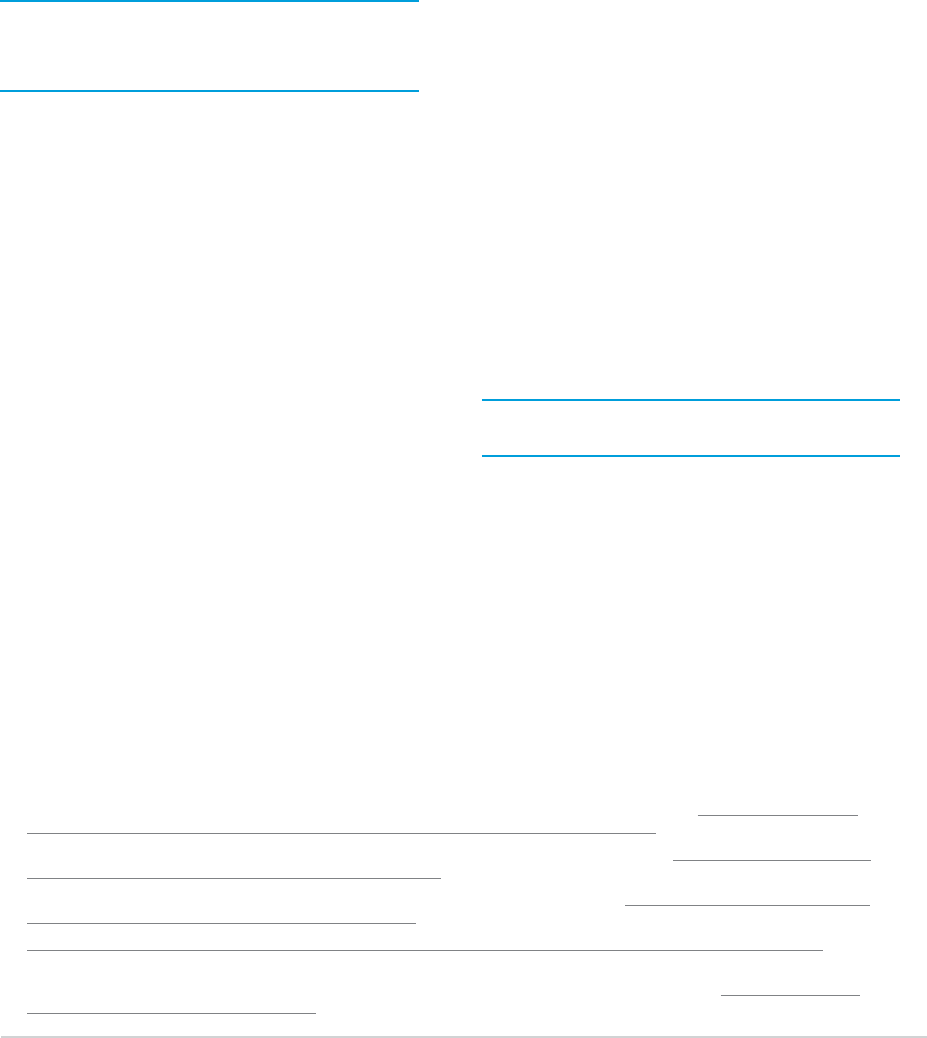
POLICY BRIEF: COVID-19 AND PEOPLE ON THE MOVE 9
Many people on the move also have limited
access to water, hygiene and sanitation, making
it harder for them to practice handwashing.
37 per cent of children and young people on
the move in the Horn of Africa do not have
access to basic sanitary facilities.
9
Access
is even further restricted for some people
on the move, such as women and girls,
older persons and those with disabilities.
COMPROMISED ACCESS
TO HEALTH SERVICES
IDPs, refugees and many migrants, especially
those in vulnerable situations, also face barriers
to accessing health services due to various
factors, including their migration status, lack of
awareness or social protection, costs, language,
disability, gender norms and cultural barriers, or
as a result of discriminatory laws, policies and
practices. In cases where no rewalls are in place
between immigration enforcement activities
and health services, refugees and migrants
who are in irregular situations or lacking proper
documentation may be unable or unwilling to
access health services, including testing, due to
fear of detention, deportation or other penalties.
People on the move also have limited access to
mental health and psychosocial services, which
have become all the more important as the crisis
exposes them to immense stress exacerbating
their already precarious conditions.
10
Furthermore,
the crisis has also disproportionately exposed
women on the move to health risks as they play
an outsized role in essential health services.
Compounding the compromised access to health
care of people on the move is their generally
limited access to critical health information, in
formats and languages they understand and trust.
Moreover, accessing health care and other basic
services is even more dicult for those who face
multiple and intersecting layers of discrimination
and exclusion in addition to their migration status,
due to their gender, sexual orientation, gender
identity, age, race and ethnicity, disability,
11
or
as a result of poverty, or homelessness.
Further, the disruption or discontinuity of
essential health services, including sexual and
reproductive health services, as a result of COVID-
19 will severely impact people on the move,
especially women, new-borns and adolescent
girls and those living in fragile, disaster-prone
or conict-affected countries. Reductions in
routine health service coverage could result in
an additional 1.2 million under-ve deaths in just
six months — with children on the move and in
conict-affected countries being most at risk.
12
RISING FOOD INSECURITY
People on the move in vulnerable situations
are also at greater risk of being affected by
COVID-19-related food insecurity resulting
from reduced agricultural activity, supply
chain disruptions, and price increases for
essential goods and a decline in purchasing
power due to the economic crisis. More than
half of the world’s refugees
13
and IDPs live in
countries and communities that even before the
9 UNICEF (2020), Children on the Move in East Africa: Research insights to mitigate COVID-19, available at: https://blogs.unicef.org/
evidence-for-action/children-on-the-move-in-east-africa-research-insights-to-mitigate-covid-19/
10 For more details see Policy Brief on COVID-19 and the Need for Action on Mental Health, available at: https://www.un.org/sites/un2.
un.org/les/un_policy_brief-covid_and_mental_health_nal.pdf
11 For more details see Policy Brief on A Disability-Inclusive Response to COVID-19, available at: https://www.un.org/sites/un2.un.org/
les/sg_policy_brief_on_persons_with_disabilities_nal.pdf
12 https://www.unicef.org/press-releases/covid-19-devastates-already-fragile-health-systems-over-6000-additional-children
13 50% of the world’s refugees are hosted in 8 food crisis countries: Turkey, Pakistan, Uganda, The Sudan, Lebanon, Bangladesh,
Jordan and Ethiopia. Global Network against Food Crises (2020), Global Report On Food Crises, available at: https://www.wfp.org/
publications/2020-global-report-food-crises

10 POLICY BRIEF: COVID-19 AND PEOPLE ON THE MOVE
current pandemic featured high levels of food-
insecurity.
14
In East Africa, for instance, at least
60 per cent of refugees in the region are already
experiencing food ration cuts forcing them to
resort to alternative means to cover their basic
needs. Disruptions in children’s diets will result
in acute wasting and stunting among children on
the move, exposing them to a lifelong impact.
CONSTRAINED
HUMANITARIAN ACCESS
All of the above risks are compounded by the
diculty of delivering humanitarian assistance
to the world’s most vulnerable people on the
move in light of cancelled ights, closed borders,
lockdown, and some countries placing export
controls on medical supplies and equipment.
This impact is especially felt among refugees
and IDPs, most of whom are dependent on
humanitarian aid. Lockdowns and restricted
access to camps in countries, such as Iraq and
Nigeria, have meant that provisions of goods and
services to IDP populations have been reduced
or limited to ‘life-saving’ activities only. There are
particular concerns that delayed preparedness
and contingency actions will increase the risk
and vulnerabilities facing IDPs and refugees
in several countries in the coming months.
The mortality resulting from a combination of
constrained humanitarian access, increased
food insecurity and the economic downturn
may well outstrip that caused by the disease
itself. This reinforces the importance of
countries exempting humanitarian goods
and personnel from movement restrictions
and of Governments supporting the UN’s
COVID-19 Global Humanitarian Response Plan
along with existing Humanitarian Response
Plans to protect the world’s most vulnerable
people from the worst effects of COVID-19.
EXAMPLES OF GOOD PRACTICES IN
ADDRESSING THE HEALTH IMPACT OF
COVID-19 ON PEOPLE ON THE MOVE
• The UK government announced that no
charges will apply for the diagnosis or treat-
ment of COVID‐19 for all foreign visitors,
regardless of their residency/immigration
status.
• In Lebanon, humanitarian agencies and health
partners undertook outreach campaigns to
provide information to refugee populations on
COVID-19.
• Peru approved temporary health coverage for
refugees and migrants suspected of or testing
positive for COVID-19.
• Thailand has long allowed migrants in irregular
situation to enroll in the national health insur-
ance scheme, ensuring that they are provided
with universal health care.
14 WFP (2020), Global Report On Food Crises, available at: https://docs.wfp.org/api/documents/WFP-0000114546/
download/?_ga=2.210567581.944391335.1590667476-100388348.1590667476

POLICY BRIEF: COVID-19 AND PEOPLE ON THE MOVE 11
2. The socio-economic impact
Necessary lockdowns, travel bans, and
physical distancing have brought many
economic activities around the world to a
severe slowdown, causing a global
recession. According to the International
Monetary Fund, the world economy is
expected to contract by 3 per cent in 2020.
Even countries with extremely low infection
rates will be severely hit by this economic
crisis. The World Bank estimates that
COVID-19 could push-up to 60 million people
into extreme poverty in 2020 alone.
15
Many people on the move tend to have few,
if any, reserves that might soften socio-
economic shocks. They are therefore among
the hardest hit by reduced incomes, increasing
unemployment, as well as increasing expenses
and price hikes for basic commodities. The crisis
has also exacerbated the already precarious
situation of women and girls on the move, who
face higher risks of exposure to gender-based
violence, abuse and exploitation, and have
increasingly limited access to protection and
response services.
16
Heightened stigma and
discrimination against persons with disabilities
within communities has also been reported.
Many migrant workers and refugees will
be deprived of their ability to contribute to
economic recovery in countries of destination
as well as to support families and communities
in their home countries. COVID-19 is projected
to result in a decline in remittances of USD$109
billion – equivalent to 72 per cent of total
ocial development assistance (ODA) in
2019 - causing hardship for the 800 million
people in those low-and-middle-income
countries that heavily depend on them.
17
At the same time, this crisis is an opportunity
for countries to ‘recover better’ through socio-
economic inclusion and decent work for people
on the move, and the provision of avenues for
regular migration. This will allow countries to
build on the positive contributions of people
on the move to their societies, which the
ongoing crisis has shone a light on. Indeed, as
recognized in the 2030 Agenda for Sustainable
Development, human mobility is inextricably
linked with sustainable development.
RISING UNEMPLOYMENT
AND LOSS OF LIVELIHOODS
COVID-19-related movement restrictions and the
economic downturn are depriving many people
on the move of their livelihoods by threatening
jobs, particularly those in the informal sector.
15 https://www.worldbank.org/en/news/press-release/2020/05/19/world-bank-group-100-countries-get-support-in-response-to-covid-
19-coronavirus
16 Protection Cluster Yemen, Preparedness and Response to Covid-19 - Protecting Groups at Disproportionate Risk, available at:
https://www.globalprotectioncluster.org/wp-content/uploads/Protecting-Groups-Preparedness-and-Response-to-Covid.pdf
17 World Bank (2020), COVID-19 Crisis Through a Migration Lens, available at:
https://www.knomad.org/sites/default/les/2020-04/Migration%20and%20Development%20Brief%2032_0.pdf

18 IOM, IOM Issue Brief on Why Migration Matters for Recovering Better from COVID 19, forthcoming
19 ILO (2018), Global Estimates on International Migrant Workers: Results and Methodology, available at:
https://www.ilo.org/wcmsp5/groups/public/---dgreports/---dcomm/---publ/documents/publication/wcms_652001.pdf
20 World Bank (2020), COVID-19 Crisis Through a Migration Lens
21 ILO (2020) Protecting migrant workers during the COVID-19 pandemic, available at: https://www.ilo.org/wcmsp5/groups/public/---ed_
protect/---protrav/---migrant/documents/publication/wcms_743268.pdf
22 Amo-Agyei, S. An Analysis of the Migrant Pay Gap, Technical Report, ILO Geneva (2020, forthcoming, available at https://www.ilo.org/
global/topics/labour-migration/; Data on informal migrant workers were available for 14 out of the 49 countries covered by the research.
Nationals also made up 70% of informal workers in the same countries examined.
SUSTAINABLE DEVELOPMENT GOALS AND TARGETS RELEVANT TO MIGRANTS
Source: IOM
18
The 164 million migrant workers
19
and their
families around the world tend to be more
exposed to the loss of employment and
wages during an economic crisis compared to
nationals. For instance, during the 2008 global
nancial crisis, the increase in unemployment
of foreign‐born workers in the EU‐28 countries
dwarfed that of native‐born workers.
20
This is
due to a combination of factors, including the
fact that cyclical sectors (construction, service
jobs) were hardest hit, and that immigrants
are frequently the last hired and rst red.
The pandemic’s socio-economic consequences
will affect in particular those migrant workers
and refugees in the low-wage informal economy
who are excluded from decent work and social
protection measures.
21
Recent ILO research
highlights the high incidence of informality
among migrant workers with nearly 75 per cent
of migrant women and 70 per cent of migrant
men working in the informal economy in many
low and middle-income countries.
22
With 30 per
cent of migrants being under 30 years of age, a
generation already faced with high youth unem-
12 POLICY BRIEF: COVID-19 AND PEOPLE ON THE MOVE
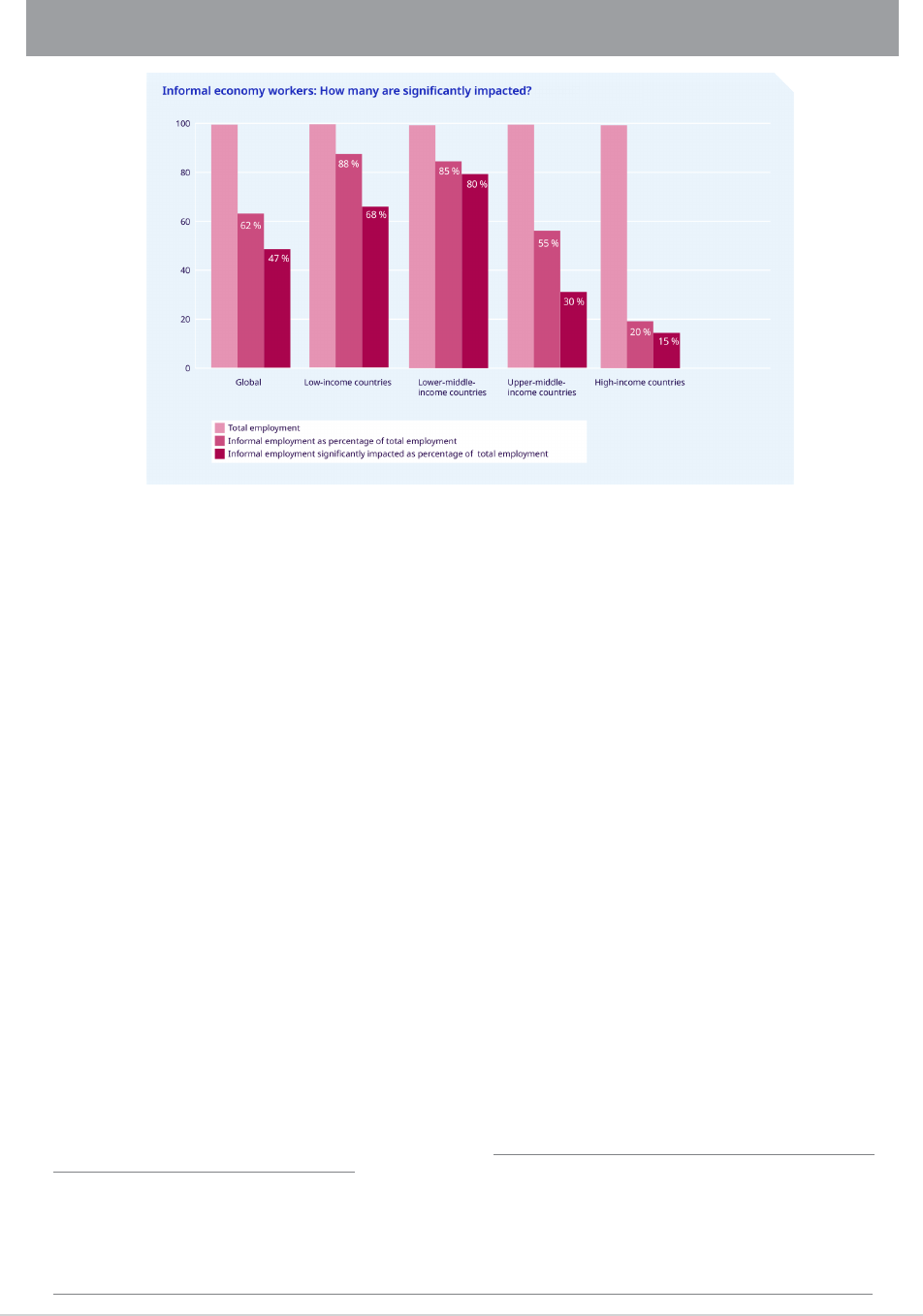
ployment risks falling further behind. ILO esti-
mated that, in the second quarter of 2020 alone,
the drop of global working hours among workers
in the informal economy would be equivalent
to the loss of over 305 million full-time jobs.
23
In Libya, for instance, unemployment among
migrants rose from 7 per cent in February to 24
per cent by late April 2020.
24
Loss of employment among migrant workers
is compounded by the fact that they are
often not covered by protections of standard
labour law or social protection systems
and the risk that layoffs could trigger the
expiration of visa or work permits, forcing
them into undocumented or irregular status
or to return to their home countries.
26
IDPs and refugees are also hit hard by the
economic downturn. Across the Middle East
and North Africa, UNHCR and its partners have
received over 350,000 calls from refugees and
IDPs during the rst ve weeks of lockdown
asking for urgent nancial assistance to
cover their daily basic needs. In Lebanon,
over half of the refugees surveyed by UNHCR
reported having lost their already meagre
livelihoods, and 70 per cent reported that
they had to skip meals. In several countries,
movement restrictions imposed on IDPs
have impeded livelihood activities and
access to land for subsistence farming.
As demonstrated during the 2008 nancial crisis,
countries with strong social protection systems
and basic services suffered the least and
recovered the fastest.
27
As of 22 May 2020, 190
countries had planned, introduced or adapted
23 ILO (2020), COVID-19 and the World of Work: Third edition, available at: https://www.ilo.org/global/topics/coronavirus/impacts-and-
responses/WCMS_743146/lang--en/index.htm.
24 Survey of 1,350 migrants conducted by IOM’s Displacement Tracking Matrix (DTM) in April 2020.
25 ILO (2020), COVID-19 and the World of Work: Third edition
26 ILO (2020) Protecting migrant workers during the COVID-19 pandemic
27 UNDP (2010), The Global Financial Crisis of 2008-10: A View from the Social Sectors, available at:
https://www.researchgate.net/publication/46468404_The_Global_Financial_Crisis_of_2008-10_A_View_from_the_Social_Sectors
IMPACT OF COVID-19 ON INFORMAL ECONOMY WORKERS (AS OF 29 APRIL 2020)
Source: ILO
25
POLICY BRIEF: COVID-19 AND PEOPLE ON THE MOVE 13

social protection programmes in response to
COVID-19, with cash transfers being the most
commonly used measure.
28
However, migrant
workers and others in the informal economy,
including refugees, are often not included in
social protection measures. That lack of income
security creates a necessity to work while sick,
with potential consequences for everyone.
DISPROPORTIONATE IMPACT ON
WOMEN, CHILDREN, PERSONS
WITH DISABILITIES AND OLDER
PERSONS ON THE MOVE
Women and girls
29
on the move tend to be
particularly exposed to a number of specic
impacts of the pandemic. Women represent
approximately 42 per cent of all migrant workers
worldwide,
30
and play an outsized role in health
services, which disproportionately expose them
to health risks. Furthermore, owing to entrenched
gender stereotypes, women on the move also
carry the majority of the burden of both paid
and unpaid domestic and care work, which is
exacerbated by the quarantines. They are also
at heightened risk of gender-based violence, in
particular intimate partner violence exacerbated
by connement and lockdown measures.
31
Risk of sexual harassment and exploitation
in light of their often-crowded living and
unsafe working conditions are also increasing.
Moreover, female migrants and refugees often
face barriers in reaching out to police, justice
or gender-based violence (GBV) services,
particularly when they are undocumented,
for fear of retaliation, stigma, detention and
possible deportation, reinforcing the need for
‘rewalls.’
32
This situation is further exacerbated
by the fact that in some situations sexual and
gender-based violence protection and response
services have not necessarily been declared
essential, making it even more dicult for
women and girls on the move to access them.
Children
33
constitute more than half of the
world’s refugees and 42 percent of all IDPs.
34
The COVID-19-related lockdowns and the
economic downturn place many families on the
edge of survival, disrupting learning, children’s
diets and exacerbating protection risks for many
children on the move. The socio-economic fall-
out of the pandemic also increases the risk of
violence, abuse and exploitation, for instance
in the form of child labour, tracking for
sexual exploitation, or child marriage affecting
adolescent girls in particular. For example,
UNHCR reports an increase in cases of child
labour and child abuse among Syrian refugees.
1.5 billion young people, over 90 per cent of
the world’s students, in 188 countries have
had their education disrupted. For children
and youth on the move, this disruption adds
to an already precarious access to education.
Even before the pandemic, refugee children
were twice as likely to be out of school than
other children.
35
As access to schools is
curtailed, more children may drop out. Learning
28 http://www.ugogentilini.net/
29 For more details see Policy Brief on the Impact of COVID-19 on Women, available at:
https://www.un.org/sites/un2.un.org/les/policy_brief_on_covid_impact_on_women_9_apr_2020_updated.pdf
30 IOM (2020), World Migration Report 2020, available at: https://publications.iom.int/system/les/pdf/wmr_2020.pdf#page=232
31 https://www.un.org/press/en/2020/sgsm20034.doc.htm
32 Global Protection Cluster (2020), Covid19 Protection Risks & Responses Situation Report No 2, available at:
https://www.globalprotectioncluster.org/2020/04/09/covid19-protection-risks-responses-situation-report-no-2/
33 For more details see Policy Brief on the Impact of COVID-19 on Children, available at: https://www.un.org/sites/un2.un.org/les/policy_
brief_on_covid_impact_on_children_16_april_2020.pdf
34 UNICEF (2020), Lost at Home, available at: https://www.unicef.org/media/68826/le/Lost-at-home-risks-and-challenges-for-IDP-
children-2020.pdf
35 UNICEF (2017), Education Uprooted, available at: https://www.unicef.org/publications/les/UNICEF_Education_Uprooted.pdf
14 POLICY BRIEF: COVID-19 AND PEOPLE ON THE MOVE

outcomes will worsen, and some will be
forced to work to offset economic strains,
potentially making a return to school after
the public health crisis subsides even more
dicult. Especially refugee or IDP girls may
never return to school. A whole generation
of young people on the move will struggle all
the more to nd jobs or start businesses.
Considering COVID-19’s disproportionally high
mortality rates among older persons,
36
older
people on the move are particularly vulnerable
to the pandemic’s health impact. This is further
exacerbated by limited access to health services,
accurate and reliable health information and
unsanitary living conditions, making this specic
group among the most exposed to the virus.
Persons with disabilities, including those who are
on the move, are also disproportionately affected
by the health impact of the pandemic, as they
are more susceptible to secondary conditions
and co-morbidities. Such impact is exacerbated
by the pre-existing inequalities faced by
persons with disabilities, including higher levels
of poverty and exclusion from education.
DECLINE IN REMITTANCES
The impact of job losses and reductions in
wages on migrant and refugee workers will also
be painfully felt by their families in their countries
of origin. According to the World Bank estimates,
remittances will decline by USD$109 billion
as a result of the pandemic.
37
Remittances
account for over 10 per cent of the GDP of 30
countries in the world
38
and are a critical source
of income for over 800 million people.
39
Early
data from Central American countries indicate
that remittances fell by 40 per cent in the latter
part of March.
40
Migrant workers’ reduction
in earnings is compounded by limited access
to remittance services due to lockdowns and
the fact that remittance service providers are
not considered essential businesses. Falling
business volumes and ongoing operating costs
could drive many of these remittance service
providers out of business, reducing market
competition and thereby impacting the global
efforts to reduce remittance transaction costs.
This resultant drop in remittances will also
impose economic hardship on the families and
communities of migrant workers, with direct
impact on household spending on education
for children of migrant workers and health care
in countries of origin. On average, 75 per cent
of remittances are used to cover essentials,
such as food, school fees, medical expenses
and housing.
41
This decline in remittances will
be all the more painful for many developing
36 For more details see Policy Brief on the Impact of COVID-19 on older persons, available at:
https://www.un.org/sites/un2.un.org/les/un_policy_brief_on_covid-19_and_older_persons_1_may_2020.pdf
37 World Bank (2020) , COVID-19 Crisis Through a Migration Lens
38 IOM (2020), Migration-Related Socioeconomic Impacts of COVID-19 on Developing Countries, Issue Brief, May 2020, available at:
https://www.iom.int/sites/default/les/documents/05112020_lhd_covid_issue_brief_0.pdf
39 https://www.un.org/development/desa/en/news/population/remittances-matter.html
40 https://voxeu.org/article/perfect-storm-covid-19-emerging-economies
41 https://www.un.org/development/desa/en/news/population/remittances-matter.html
POLICY BRIEF: COVID-19 AND PEOPLE ON THE MOVE 15
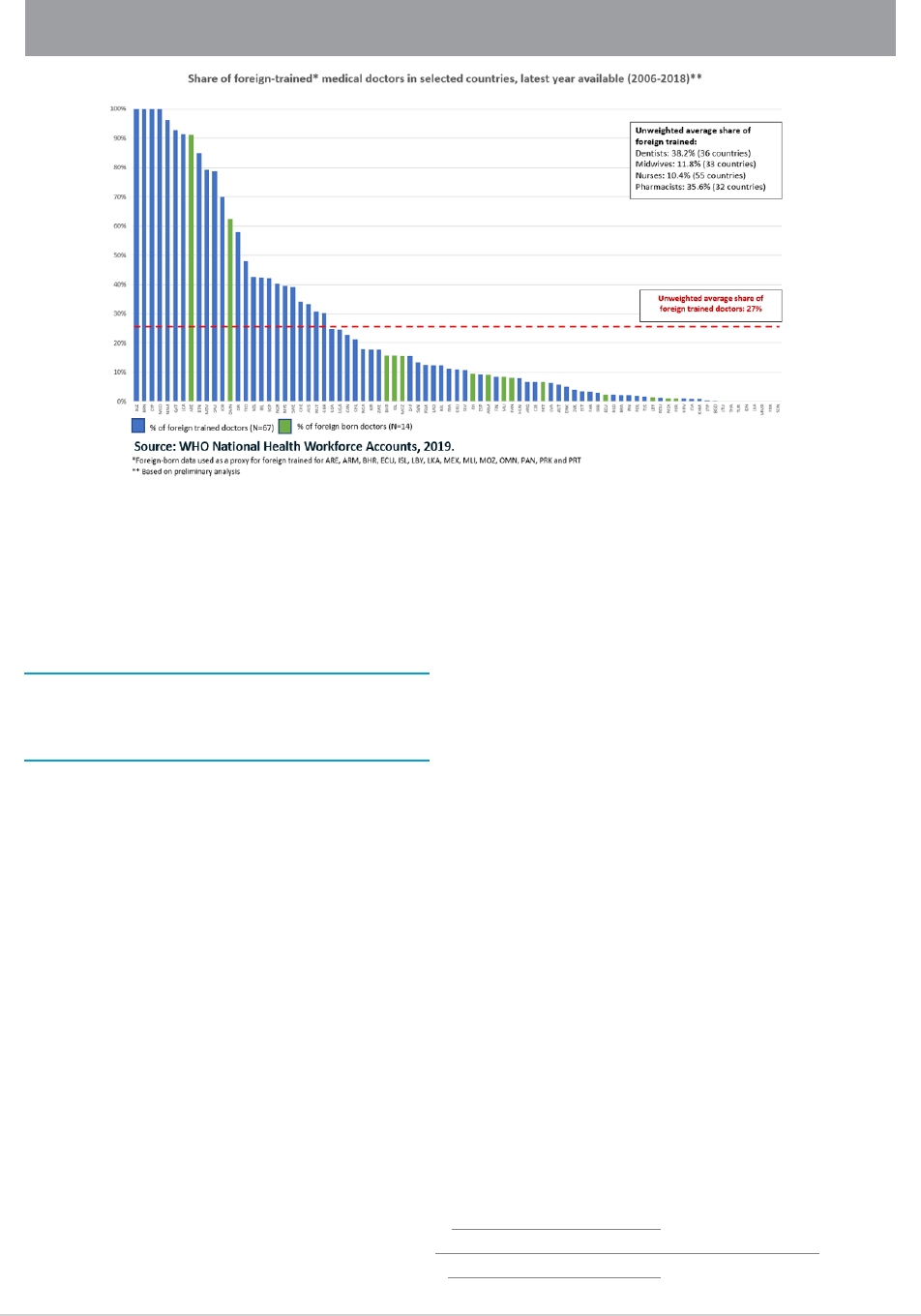
countries, particularly as direct foreign
investment is expected to fall by an even
larger share in 2020 than remittances.
42
THE CONTRIBUTION OF PEOPLE
ON THE MOVE TO SOCIETIES
The signicant impact of COVID-19 on migrant
workers and refugees notwithstanding, the
pandemic has shown the immense contribution
that these groups make to the societies they
live in. Millions of migrants and refugees are at
the frontline of the response or play a critical
role as essential workers, in particular in the
health sector, the formal and informal care
economy, and along food supply chains. Data
from over 80 WHO Member States indicate
that across countries over a quarter of doctors
and a third of dentists and pharmacists are
foreign-trained and/or foreign-born.
43
About
one in eight of all nurses globally is practicing
in a country different from where they were
born.
44
Migrant and refugee workers form
a signicant percentage of health workers
involved in the COVID-19 response in developed
countries. Across the globe, thousands of
migrants and refugees are working with national
health systems responding to the pandemic,
and several countries are accelerating
the accreditation of refugee and migrant
health workers so that they can contribute
to the response. While health workers are
considered essential, some of them remain
undocumented in the country where they reside.
The important contribution made by people on
the move to the societies they live in has also
been felt in other essential sectors, such as the
food supply chain. For example, the crisis has
42 World Bank (2020), COVID-19 Crisis Through a Migration Lens
43 Data extracted from the WHO NHWA Data Platform, available at: https://apps.who.int/nhwaportal/
44 WHO (2020), State of the World’s Nursing Report, available at: https://www.who.int/publications-detail/nursing-report-2020.
45 Data extracted from the WHO NHWA Data Platform, available at: https://apps.who.int/nhwaportal/
SHARE OF FOREIGN-TRAINED MEDICAL DOCTORS IN SELECTED COUNTRIES
Source: WHO
45
16 POLICY BRIEF: COVID-19 AND PEOPLE ON THE MOVE

led to a shortage of seasonal farm workers in
the agriculture sector in North America, which is
heavily dependent on migrant workers. Similarly,
in Europe, there is an estimated shortfall of up
to one million seasonal agricultural workers.
46
This crisis therefore offers an opportunity to
evaluate the positive contributions of people
on the move to societies and the critical role
of migration in countries of destination more
broadly. For countries to “recover better”, it will
be important to explore further how to facilitate
the recognition of academic and professional
qualications earned abroad, include migrants
and refugees in social protection systems,
and facilitate safe, orderly and regular
migration so that societies may benet from
the full potential of migrants and refugees.
Similarly, record numbers of IDPs and refugees
continue to live in protracted displacement.
47
The response to COVID-19 has the potential
to strengthen efforts to end protracted
displacement and support durable solutions,
through economic and social integration,
and to inclusion of displaced persons in
national development plans. Earlier this year,
the Secretary-General launched a High-
Level Panel on Internal Displacement to
bring visibility to the issue and to elaborate
recommendations for improving the response
and achievement of durable solutions for
IDPs, which have become all the more
pressing in light of the current pandemic.
46 IOM (2020), Covid-19: Policies and Impact on Seasonal Agricultural Workers, available at:
https://www.iom.int/sites/default/les/documents/seasonal_agricultural_workers_27052020_0.pdf
47 OCHA (2017), Breaking the Impasse, available at: https://www.unocha.org/sites/unocha/les/Breaking-the-impasse.pdf
POLICY BRIEF: COVID-19 AND PEOPLE ON THE MOVE 17

EXAMPLES OF GOOD PRACTICES IN ADDRESSING THE SOCIO-ECONOMIC
FALL-OUT OF COVID-19 ON PEOPLE ON THE MOVE
• Peru, Chile and Argentina recently began allowing foreign-trained refugee doctors, nurses and others with
medical training to work during the COVID-19 response.
• In Ireland, the Medical Council has announced it would allow refugees and asylum-seekers with med-
ical training to help in providing essential medical support by taking up roles, including as healthcare
assistants.
• Ukraine passed a law to ensure that IDPs receive social benets throughout the lock-down period.
• Humanitarian actors in Burkina Faso, Chad, Guinea, and Liberia continue to pay teacher incentives during
the closure of schools for refugee teachers to ensure continuity of income.
• The South African Government conrmed that 30 per cent of nancial support for small convenience shop
owners will go to foreign-owned businesses, including those owned by refugees.
• The Philippines is extending stipends to migrant workers to ensure that migrant workers are still able to
travel when they have valid employment contracts.
• Bahrain has established specic responsibilities for employers (and workers) in the private sector to
ensure appropriate accommodations and facilities for migrant workers during the pandemic.
• In Turkey, the government has long been providing training, certication and authorization for refugee
health professionals to practice in refugee health centres and deliver primary health care services to
refugees free of charge.
18 POLICY BRIEF: COVID-19 AND PEOPLE ON THE MOVE

3. The human rights
and protection impact
As a result of COVID-19 international
mobility has been severely constrained with
often dramatic implications for people on
the move. In an effort to contain COVID-19’s
spread, countries around the world have
implemented border closures, travel
restrictions, and lockdowns. As of 21 May
2020, IOM reports that 221 countries,
territories and areas have implemented
travel restrictions.
48
While many of these measures have been
necessary in light of our collective struggle
against the pandemic, it is clear that keeping
human rights considerations at the fore
ensures better outcomes for everyone.
49
But the
impact on the human rights of people on the
move and the specic rights and protections
afforded to refugees and IDPs has not always
been suciently taken into account.
50
As a
result, many people on the move now nd
themselves trapped in deeply precarious
situations. People trying to ee persecution,
war, violence and other human rights violations
are prevented from accessing the protection
they need. Migrants, including unaccompanied
and separated children, have been deported to
their home countries, which are ill-equipped to
receive them in safety, or have been stranded
in border areas unable to return home.
Growing incidents of stigmatisation, xenophobia
and discrimination have in certain situations
led to forced evictions of refugees, migrants
and IDPs from their homes, leaving many
without shelter and prone to forced returns.
CURTAILED ACCESS TO
ASYLUM AND PROTECTION
Travel restrictions and border closures have
put the fundamental norms of international
human rights and refugee law under strain.
As of 22 May 2020, UNHCR reports that 161
countries have so far fully or partially closed
their borders to contain the spread of the virus.
At least 99 States are making no exception
for people seeking asylum seriously limiting
their rights. Denials of entry and pushbacks of
asylum-seekers and unaccompanied migrant
children at frontiers have been reported in
different regions and so have been refusals to
allow refugees and migrants rescued at sea to
disembark. In some cases, States have returned
asylum-seekers to transit countries to await
48 IOM (2020), Global Mobility Restriction Overview, available at:
https://migration.iom.int/reports/dtm-covid19-travel-restrictions-output-%E2%80%94-14-may-2020?close=true&covid-page=1
49 For more details see Policy Brief on the COVID-19 and Human Rights: We are all in this together, available at:
https://www.un.org/sites/un2.un.org/les/un_policy_brief_on_human_rights_and_covid_23_april_2020.pdf
50 Zolberg Institute on Migration and Mobility (2020), Human mobility and human rights in the COVID-19 pandemic: Principles of protec-
tion for migrants, refugees, and other displaced persons persons signed by 1,000 academics from around the world, available at: https://
zolberginstitute.org/covid-19/
POLICY BRIEF: COVID-19 AND PEOPLE ON THE MOVE 19

lifting of the restrictive measures, while in other
countries refugees were forcibly sent home in
violation of the principle of non-refoulement.
In addition, access to asylum procedures has
been hindered in some countries, while others
have suspended processes for providing
refugee or other forms of protection.
DETENTION, FORCED RETURNS
AND DEPORTATIONS
Government responses to COVID-19 have
also exposed migrants to increased risk of
immigration detention, family separation and
forced or risky returns without due process
and basic safeguards. Some States have used
public health concerns to justify certain types of
immigration enforcement measures, including
raids and arbitrary detentions of undocumented
migrants and refugees who are often held in
overcrowded facilities, with both detainees and
staff exposed to heightened risks of infection.
51
Several countries expelled and forcibly
returned migrants to States with fragile health
systems,
52
exposing them and their receiving
communities to serious public health risks.
53
STRANDED MIGRANTS,
FAMILY SEPARATION AND
HUMAN SMUGGLING
As borders were shut, many migrant workers
found themselves stranded in countries of
destination or transit, while others who lost
their jobs have had their visas revoked or
suspended and were placed in overcrowded
facilities before being returned home. COVID-
19 is also leading to protracted separation of
families on the move as family reunication
procedures are put on hold, or because families
are split across borders that remain closed
without allowing for humanitarian exceptions.
With borders closed, both refugees trying
to ee war and persecution and stranded
migrants desperate to make it home or to their
destination are more prone to seek the services
of human smugglers, exposing themselves to
the threat of human tracking, exploitation
and endangering their lives, as we already see
happening in different parts of the world.
54
Due to their more precarious working and
living conditions, undocumented migrants and
seasonal workers, especially those engaged
in domestic work, face greater vulnerability to
falling prey to criminal networks engaged in
tracking in persons. Further, with movement
restrictions diverting law enforcement resources
and reducing social and public services,
tracking victims face little hope of accessing
justice and essential services, with the closure or
reduction of specialized hotlines and shelters.
55
51 United Nations, Network on Migration (2020), COVID-19 & Immigration Detention: What Can Governments and Other Stakeholders Do?,
available at: https://migrationnetwork.un.org/sites/default/les/docs/un_network_on_migration_wg_atd_policy_brief_covid-19_and_
immigration_detention.pdf
52 R4V (2020), COVID-19 Update, available at: https://r4v.info/en/documents/download/75767
53 https://migrationnetwork.un.org/sites/default/les/network_statement_forced_returns_-_13_may_2020.pdf
54 https://www.ozy.com/around-the-world/the-coronavirus-is-driving-the-biggest-migration-in-the-americas-underground/291984/ and
https://lasillavacia.com/silla-llena/red-de-venezuela/los-migrantes-se-llevan-lo-peor-de-la-crisis-del-covid-19-76290;
55 UNODC (2020), Impact of the COVID-19 Pandemic on Tracking in Persons, available at: https://www.unodc.org/documents/Advocacy-
Section/HTMSS_Thematic_Brief_on_COVID-19.pdf
20 POLICY BRIEF: COVID-19 AND PEOPLE ON THE MOVE

THE SPECTRE OF COVID-19
DRIVING FURTHER
DISPLACEMENT
There is the risk that the current pandemic will
cause further displacement in some places
where people do not feel protected. The
experience during the Zika and Ebola epidemics
suggest pandemics can cause displacement
as people look for protection elsewhere. Today,
some IDPs are already reported to be eeing
camps or informal settlements out of fear of
COVID-19, whereas internal migrant workers are
compelled to move back to rural communities
in large numbers due to the lockdown. And
diminished access by refugees and migrants
to local services and economic opportunities
in their host countries could trigger irregular
onward movements to other countries.
Moreover, in several countries, governmental
responses to the pandemic, with sometimes
heavy-handed or militarized approaches, have
led to social unrest and erosion of trust in
public authorities, especially in areas where the
social contract was already weak. Decisions to
postpone elections due to the pandemic or to
hold them despite the crisis might be exploited
for political gains and may increase political
tensions. The pandemic’s socio-economic
fall-out will also add stressors especially on
fragile countries. And while several conict
parties have committed to abide by the
Secretary-General’s call for a global ceasere,
in a number of conict settings, we have seen
armed groups stepping up attacks presumably
in efforts to take advantage of COVID-related
lockdowns. All these developments could,
in turn, lead to further displacement.
EPIDEMICS AS A DRIVER OF DISPLACEMENT
The Ebola epidemic, which spread through various
West African countries in 2014, provides some
insights into how epidemics can cause displace-
ment. An analysis by the Internal Displacement
Monitoring Centre (IDMC) from 2014 demonstrates
that the Ebola epidemic led to ve internal displace-
ment trends – these trends could, however, play
out both within a country’s border as well as across
international borders:
1. Fleeing the virus: Fear of being exposed to
the virus and falling ill due to lack of protective
measures has driven people to move as a pre-
ventive measure.
2. Fleeing quarantine: Displacement due to com-
munities eeing from quarantine, either before
or after quarantines were imposed.
3. Seeking health care: As rural areas tend to
be poorly served by health care facilities, this
forced many to ee to urban areas in need of
better health care.
4. Forced evictions and eeing stigma:
Patients who recovered could face stigma and
other challenges, including forced eviction,
forcing them to ee.
5. Fleeing violence and rights violations:
Violence and human rights violations as a
result of the epidemic could also force people
to ee.
56 https://www.internal-displacement.org/expert-opinion/displaced-by-disease-5-displacement-patterns-emerging-from-
the-ebola-epidemic
Source: Internal Displacement Monitoring Centre (IDMC)
56
POLICY BRIEF: COVID-19 AND PEOPLE ON THE MOVE 21

EXAMPLES OF GOOD PRACTICES IN ADDRESSING THE PROTECTION
IMPACT OF COVID-19 ON PEOPLE ON THE MOVE
• The Portuguese government announced that all migrants and asylum-seekers with pending residence
applications will be treated as permanent residents until 30 June 2020. This measure will grant migrants
full access to public social security systems, including health care.
• Ecuador has extended the deadline for Venezuelan migrants on its territory to apply for a humanitarian
visa until the end of the state of emergency.
• Immigration and international protection permissions issued by the government of Ireland due to expire
before 20 May are automatically renewed for a period of two months on the same conditions as the exist-
ing permission.
• Chile has set up an online system through which visas and stay permits are automatically extended for six
months, upon request.
• Uganda has waived the usual nes applied to visa overstayers for permits expiring during the lockdown
period.
• The European Commission adopted guidance on the implementation of relevant EU rules on asylum and
return procedures and on resettlement in the context of the coronavirus pandemic for its Member States,
underlying that any restrictions in the eld of asylum, return and resettlement must be proportional, imple-
mented in a non-discriminatory way and take into account the principle of non-refoulement and obliga-
tions under international law.
• According to UNHCR, several States have adapted their systems to carry out remote asylum processing
or have extended documentation and rights to remain pending capacities to carry out asylum procedures
safely. Some 82 States are adapting registration of new asylum applications by mail, phone, email or other
online mechanism, while some 86 States are adapting measures to issue new or extend the validity of
asylum documentation.
• New Zealand and Australia have extended the visas of the seasonal migrant workers to enable them to
remain in the countries, thus allowing them to continue working during the lockdown.
• Panama is offering shelter to stranded migrants while international travel restrictions are in place.
22 POLICY BRIEF: COVID-19 AND PEOPLE ON THE MOVE

4. The future of human mobility
As mobility in many parts of the world has
ground to a halt, there are concerns that in
the mid- to long-term some of the current
movement restrictions could outlast the
immediate crisis. This could erode legal
obligations related to access to protection
under international human rights and
refugee law, as well as established practices
and norms around mobility. It also risks
reducing the benecial impact of migration
to countries of destination and origin.
Based on current developments, it is likely
that countries, as they gradually reopen
international borders, will impose additional
health requirements for travel, increasing the
need for health assessments, testing, screening,
immunization, treatment, and certication.
These requirments might disadvantage
vulnerable individuals, who may be stranded
or detained for indeterminate periods, have
to self-nance periods of quarantine or face
disproportionate health expenditures. Such
efforts could also drive more people into
irregular pathways. Furthermore, ad hoc
measures, put in place by governments
focused on containing the threat of the virus,
may engender an unworkable patchwork
of travel requirements, which would make
journeys more arduous and uncertain
than before and create new burdens on
private sector actors facilitating travel.
To prevent such requirements and ad hoc
measures from imposing overly burdensome
and prolonged constraints in international
travel and from running counter to their
commitments under International Health
Regulations (IHR, 2005),
58
it will be important to
ensure that such measures remain proportional
to public health risks and evidence-based.
It is equally important for countries to work
together to ensure common standards for
border management and travel which respect
human rights, privacy and data protection.
59
If some channels of migration are not reopened
once the crisis has subsided – whether due to
economic, political or public health risk concerns
– then the dynamics of migration are likely
to shift, with concomitant effects on people
and communities globally. Furthermore, the
recognition during this crisis of some migrant
workers as ‘essential’ should not serve as a
basis for a two-tier future migration system
purely based on essential and non-essential. Our
collective dependence on the vital contributions
of workers across sectors and industries with
a migrant or refugee background helps to
propel us to rethink human mobility, turn the
tide on anti-migrant discourses and make our
immigration systems pandemic-resilient.
58 WHO (2005), International Health Regulations, available at: https://www.who.int/ihr/publications/9789241580496/en/
59 IOM (2020), COVID-19 Emerging Immigration, Consular and Visa Needs and Recommendations, available at: https://www.iom.int/sites/
default/les/documents/issue_brief_2_-_ibm_052020r.pdf
POLICY BRIEF: COVID-19 AND PEOPLE ON THE MOVE 23

Four basic tenets to advancing safe
and inclusive human mobility during
and in the aftermath of COVID-19
As this crisis unfolds, we are reminded again of
the importance of addressing human mobility
in a safe and inclusive way for the benet of
our own communities and economies, as well
as migrants, IDPs and refugees themselves.
This crisis is an opportunity to reimagine
human mobility for the benet of all while
advancing our central commitment of the
2030 Agenda to leave no one behind. It is
tting to build on the recognition of the vital
role played by people on the move to redouble
our efforts to combat discrimination against
them; to ensure that those in need of protection
are able to safely and promptly access it; to
health-proof human mobility systems; and to
strengthen global migration governance and
responsibility sharing for refugees, as already
envisaged by the Global Compacts on Refugees
and for Safe, Regular and Orderly Migration
and as spelled out in relevant international
human rights and refugee instruments.
To this end, the following four areas
are of particular relevance.
1. Exclusion is costly in the long-run whereas
inclusion pays off for everyone. As the
virus does not discriminate by nationality
or migration status, we cannot afford to
discriminate in our response. Exclusion
of people on the move is the very same
reason they are among the most vulnerable
to this pandemic today. Only an inclusive
public health response will enable us to
address the virus. This also requires ded-
icated efforts to ensure equitable access
to a COVID-19 vaccine for people on the
move, once such a vaccine becomes
available. Only inclusive socio-economic
recovery packages that include migrant
workers, refugees and IDPs will help our
economies restart and stay on track to
reach the Sustainable Development Goals.
2. Responding to the pandemic and protecting
human rights of people on the move are
not mutually exclusive. We should not let
our resolve to address this unprecedented
crisis undermine our collective responsibility
to respect the rights of people on the move
and protect them from further harm. As
many countries have demonstrated, travel
restrictions and border control measures
necessary to control the pandemic can
be safely implemented in full respect of
international human rights, international
humanitarian and international refugee
law, as well as labour standards.
3. No-one will be safe until everyone is safe.
The pandemic and its knock-on effects
will hit hardest those who were already
the most vulnerable before the crisis. This
includes people on the move in precarious
circumstances, as well as those in fragile
and conict-affected countries, in particular
women, children and older persons.
Lifesaving humanitarian assistance must
continue to reach persons in need even
during times of lockdown. Social services
24 POLICY BRIEF: COVID-19 AND PEOPLE ON THE MOVE

that prevent and respond to gender-based
violence, child abuse or exploitation must
continue to operate without disruptions.
All children on the move must continue
to have access to learning – whether by
extending access to no tech, low tech or
digital solutions while schools are closed or
safely reopening education services as soon
as possible. For all of us to be safe, access
to diagnostics, treatment and vaccines
must be universally accessible, without
discrimination based on migration status.
4. People on the move are part of the solution.
They are at the frontline providing health
care services and keeping our global
food production and supply chains going.
We need to value and recognize their
contributions to our societies. The best way
to do so is by facilitating the recognition
of their qualications; by ensuring that
human mobility remains safe, inclusive
and respectful of international human
rights and refugee law; and by exploring
various models of regularisation pathways
for migrants in irregular situations.
Furthermore, by keeping remittances
owing and bringing transaction costs as
close to zero as possible, we can help them
support their families and communities
in their home countries, contributing
to our collective efforts to achieve the
Sustainable Development Goals by 2030.
No one country can ght the virus alone and no one
country can manage migration alone. But together,
we can do both: contain the spread of the virus,
buffer its impact on livelihoods and communities
and recover better, together.
POLICY BRIEF: COVID-19 AND PEOPLE ON THE MOVE 25
